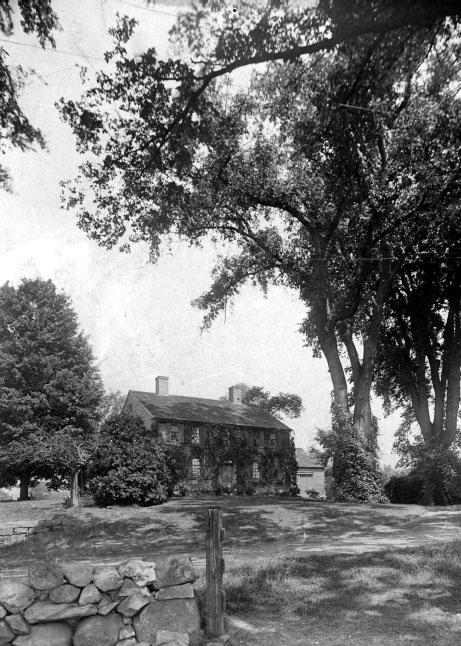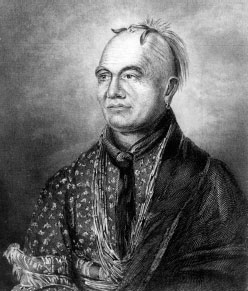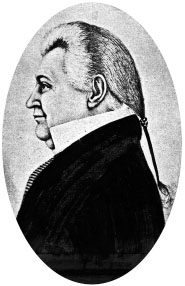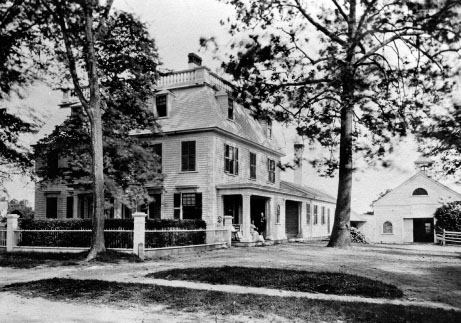Framingham Legends & Lore (10 page)
Read Framingham Legends & Lore Online
Authors: James L. Parr

Framingham's most prominent Loyalist was Nathaniel Brinley. He leased the old Joseph Buckminster property on Millwood and Winch Streets beginning in 1760. Although the farm was a large one and a source of income for Brinley, he apparently maintained it as a summer estate and a seasonal residence. (The farm employed a large number of servants, both white and black, including one Daniel Shays, who became famous for leading a revolt against the state government in 1786.) When the war broke out, the Brinleys were at their residence in Boston, but four months following the British evacuation in March 1776 Nathaniel was arrested. His only offense seems to have been that he had signed an address to Governor Gage, which his wife later maintained had been done only under duress. The authorities in Boston decided that to be on the safe side he should be confined to Framingham. Not only had he already been at least a seasonal resident of the town, but as in the case of John Loring, Framingham was securely in Patriot hands and safely distant from the coast.
The Committee of Safety in Framingham took its responsibility to secure Brinley quite seriously. It placed him in the custody of John Fiske, who resided on the southeast corner of Walnut and Main Streets. Not only did he have to labor on Fiske's farm, but he was also not allowed to stray more than twenty rods from the dwelling house without being accompanied by Fiske and was denied the use of pen, ink and paper. When his wife appealed that his treatment in Framingham went far beyond his sentence, the council in Boston clarified that Brinley was to be confined within the borders of the town but not otherwise restrained. The Committee of Safety appealed this ruling to the Massachusetts House of Representatives, citing that Brinley had expressed his Loyalist leanings and must have had advance notice of the British march on Lexington, as he had moved his family and most of his furnishings out of Framingham in the weeks before April 19. The response to this appeal was more ambiguous, stating only that Brinley was to remain under the jurisdiction of the Committee of Safety in Framingham.
Meanwhile, Brinley had been transferred to the farm of Benjamin Eaton and placed under the additional burden of not being allowed to speak to anyone, including his wife, unless Eaton himself or another member of his family was present. Finally, after about a month, the Massachusetts Council and House of Representatives acting in concert took pity on the beleaguered Brinley and sent him to his kinsman Francis Brinley of Newport, Rhode Island, requiring only that he post £600 bond. Brinley's Tory leanings could not have been that strong; unlike most Loyalists, who fled to England or Canada, after the war he settled in Tyngsborough, Massachusetts, where he died in 1814 at the age of eighty-one. His old property in Framingham, which he had never actually owned, continued to be known as the “Brinley Farm” for generations.
T
HE
O
RDEAL OF
J
ONATHAN
M
AYNARD
Jonathan Maynard was born on January 22, 1752, the son of Jonathan and Martha (Gleason) Maynard. His parents' house was located on the north side of Salem End Road, a few hundred yards to the east of the Temple Street intersection. His grandfather, also named Jonathan Maynard, had moved to Framingham from Sudbury in 1713 and established a tavern in the house that he bought from John Towne that still stands on the north side of Maple Street. (Towne was the nephew of the three sisters tried as witches at Salem whom we met in
Chapter Two
.)
Jonathan graduated from Harvard College with the class of 1775, just in time for the outbreak of the American Revolution. He was still in Cambridge in April 1775, and therefore missed the Battle of Lexington and Concord, unlike his older brother William and cousins John and Needham Maynard, who were Minutemen from Framingham. He enlisted within the week, however, and served alongside the three of them at the Battle of Bunker Hill in June of that year.
Maynard served in the army throughout the war. He participated in the Battles of Stillwater and Saratoga, but the most famous incident of his military career occurred at the little-known Battle of Cobleskill in central New York on May 30, 1778. There Mohawk and Tories under the command of Chief Joseph Brant burned the settlement to the ground, and Maynard's unit, which was trying to relieve the settlers, was driven back with heavy casualties. The rest of his company was killed but, as he was a lieutenant and wore a sword, he was taken captive and brought before Brant himself. According to lore, the chieftain had determined that Maynard would be burned alive, but as he was being tied to the stake, the Masonic symbols on his arms became visible. Brant recognized Maynard as a fellow Freemason and stayed his execution, instead conveying him as a prisoner to British-held Quebec. There he remained for well over two years until he was exchanged on December 26, 1780. He was promoted to the rank of captain before finally leaving the service on November 19, 1782.
Variations of this tale are told about three other American officers. According to various Masonic and Revolutionary histories, Colonel John McKinstry, Major John Wood and Lieutenant Thomas Boyd all employed the lifesaving Mason's distress signal to avoid a horrid death at the hands of Chief Brant. While we will not try to evaluate the credibility of the stories regarding the other officers, there is some evidence supporting Maynard's tale.

House built by John Towne, nephew of convicted witch Sarah Clayes; it later became the Jonathan Maynard tavern.

Mohawk chief Joseph Brant.

Captain Jonathan Maynard.
We know through official army documents and contemporary diaries that Maynard was indeed captured at the Battle of Cobleskill on May 30, 1778, in a fight against Brant's Mohawk and was held prisoner until 1780. Maynard had joined the Masons the previous winter along with a number of fellow officers while bivouacked outside Albany. Perhaps what is the strangest part of the tale is easiest to believeâthat a Native American chieftain could have been a Mason. For Brant was no ordinary Mohawk; he had been educated at the Indian school conducted by Dr. Eleazer Wheelock, who went on to found Dartmouth College; he was well traveled in the white world and had recently returned from a trip to Europe, where he was presented to the Court of St. James. He was already a legendary commander, so it is not impossible to believe that he might have joined the order while in England.
In the very least, Maynard seems to have told the tale himself during his lifetime. The memoir of Neal Dow, the Civil War general and national temperance leader who married a granddaughter of Jonathan's older brother William, recounts Dow's having visited the old man in Framingham during the summer of 1830. (Interestingly, Dow relates the story of the ordeal as a tale of how Maynard's hair had turned white almost overnight as a result of the scare put into him by his near execution.) In his biography of Brant published in 1838, William L. Stone published the excerpt of a letter telling of Maynard's account written by George Folsom, an attorney in Worcester from 1830 to 1837. It seems likely that Folsom may have known Maynard personally. Furthermore, Folsom was well respected as a historian, having been an early contributor to the American Antiquarian Society, chairing its publications committee and, after 1838, the New York Historical Society.
After the war, Maynard returned to Framingham and married Lois Eaton on May 30, 1784. He erected a house on the west side of Pleasant Street, just north of the intersection with Maynard Road, which still stands today. He soon became one of the town's most prominent citizens, serving at one time or another as justice of the peace, selectman, town clerk, state representative, state senator and Framingham's first postmaster. In his will, he designated half a township in Washington County, Maine, be granted for the benefit of Framingham Academy.
Perhaps it was a sign of gratitude toward the institution that saved his life when Maynard played a key role in the founding of the Middlesex Lodge of Masons in Framingham. He served as the lodge's first master and offered the large third floor of his home as a meeting place for many years. The most notable meeting occurred during that first year at the Maynard house when Paul Revere himself, in his capacity as grand master of the Grand Lodge of Massachusetts, presided over the formal installation of officers on November 25, 1795. Maynard died on July 17, 1835.

The Captain Jonathan Maynard house on Pleasant Street.
T
HE
L
EGACY OF THE
R
EVOLUTION IN
F
RAMINGHAM
To a remarkable degree, given its proximity to these great events, the town of Framingham emerged from the Revolution relatively unscathed. Individual lives were changed, surely, but it had not wrought the devastation and wrenching changes as had King Philip's War a century earlier.
The new Massachusetts constitution ended slavery for good in 1783, but there had never been that many slaves in Framingham (although two of them played remarkably prominent roles in the Revolutionary era). Unlike in some communities, there was not a significant displaced Loyalist local eliteâonly poor Nathaniel Brinley was forced from town, and he had been a renter, not an owner, and evidently not that ardent a Tory at that. The war had been the formative experience for a new generation of leaders, but most of themâBuckminster, Maynard, Nixon, Trowbridge, et al.âalready came from well-established families.
In the end, Framingham was still a quiet farming town. The coming nineteenth century, with its new technologies, new immigration, (mostly) peaceful revolutions in transportation, markets and the first hints of a consumer culture, would do far more to change everyday life in Framingham.
Chapter Four
THUNDER SENT FROM HEAVEN
W
EIRD
W
EATHER
While the previous chapters have dealt with the acts of men and women, no history of Framingham would be complete without also chronicling what the insurance industry calls “acts of God.” Given the Puritan heritage of most of Framingham's earliest English settlers, it was not a phrase taken lightly.
Today's weather watchers have an amazing amount of resources available to them for predicting meteorological events. Up-to-the-minute satellite and radar images can be accessed by Internet, television and even cell phone. Every winter storm is treated as a major blizzard by TV forecasters, with continuous coverage beginning days before the first flake ever falls. Over the centuries, Framingham's citizens have endured momentous, even catastrophic weather events without even a moment's warning, beginning with the first settlers in the seventeenth century. Hurricanes, tornadoes, blizzards, ice storms, lightning and even earthquakes have plagued Framingham for over three hundred years.
